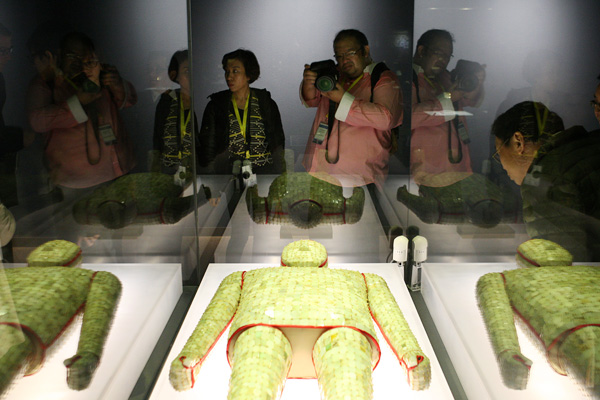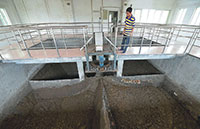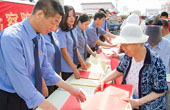Xuzhou Museum: life, brutal death and a luxurious afterlife
By Erik Nilsson (China Daily) Updated: 2015-12-07 08:32
 |
|
Journalists examine funerary suits tailored with thousands of jade tiles sewn with metal thread at the Xuzhou Museum. [Photo by Wang Zhuangfei/China Daily] |
The Xuzhou Museum deals with the luxuries of life — and the homicidal contraptions devised to force its violent conclusion.
It's fitting that the first floor is devoted to war.
The 2,600-year-old settlement of Xuzhou withstood more than 200 battles throughout imperial times as Jiangsu province's oldest city.
Yet weapons found in the area hark as far back as the Neolithic age, when bamboo bored holes into stone axes. Next to the blades of rock is a replica of a human femur that sports an arrowhead.
The display shows why armor was developed. Other exhibits at the museum show how.
A 10-kilogram suit of Han Dynasty (206 BC-220 AD) iron armor consists of 2,000 plates. Statues of a Song Dynasty (AD 420-479) horse and general sport armor from their era. Displays of Yuan Dynasty (1271-1368) breastplates show how chain mail's agility gave the Mongolian civilization's military advantage — agile horsemanship.
Visitors can lift the sleeves of replica chain mail to feel its hidden heft.
The ornate spears of the Han generals were purely ceremonial — nothing you'd bring to actual combat. But many weapons used for the actual dirty work of spilling blood and guts were grisly, rather than pretty.
Take shields beset with spikes in the center and angry hooks clawing from the top and bottom. Or curved blades with long handles designed to separate charging horses from their hooves. A crossbow from the era could kill from 80 meters.
A hunk of encased earth from Ming Dynasty (1368-1644) weaponry is a honeycomb of crusty helmets.
Cherry bombs, it appears, are nearly as old as gunpowder and are displayed with bronze gun barrels among the first firearms. A Qing Dynasty (1644-1911) cannon and cannonballs are also displayed nearby.
While the first floor is devoted to death on the battlefield, the other two focus on life — well, mostly the afterlife, where you go if you die in battle, or from any other cause.
Most of the displays on the second and third floors — respectively devoted to jade and pottery — are funerary. There are two actual tombs behind the main hall.
The jade is mostly extracted from local kings' tombs found in Shizi Mountain in 1995.
- Hundreds of fugitives are brought back since April
- New steps will simplify driving training and tests
- Capital opens door to hukou applicants
- Nobel Prize 'to spur TCM development'
- Beijing lifts red alert but smog will be back in two days
- Psychiatrist links smog, depression
- Weather a bonanza for taxi services
- Lawyer: Top court OKs death sentence in poisoning case
- Power for ministries to be clarified
- Red alert helps to reduce pollutants, say experts







